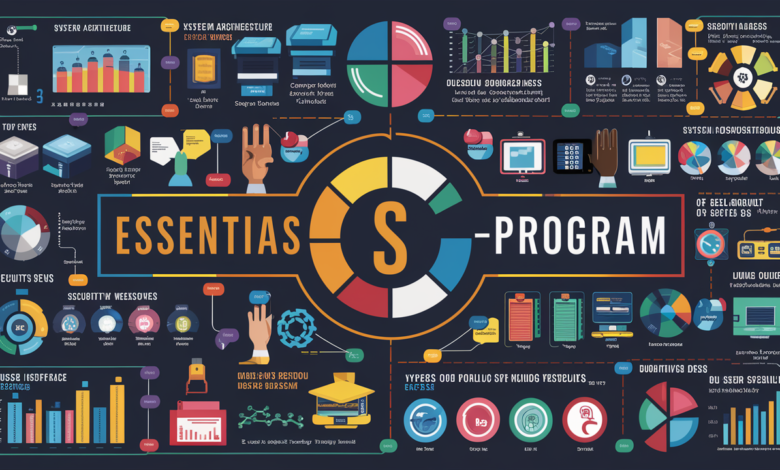Everything You Need to Know About OS-Program: Simplifying the Power of Operating Systems

An OS-program is the heart of every device we use today, from smartphones to computers. It is a system software that helps manage the device’s hardware and software resources. Without an OS-program, the device wouldn’t function properly, as it coordinates everything in the background to ensure smooth operations.
Whether you are browsing the internet, playing a game, or using an app, the OS-program is working hard to manage memory, storage, and other essential functions. In this blog, we’ll dive into how these OS-programs work and explore their role in making your devices smarter and faster.
What is an OS-Program and Why Is It So Important
An OS-program is a type of software that helps manage the hardware and software of a device, such as a smartphone, tablet, or computer. Without an OS-program, the device wouldn’t be able to function properly. It controls how things like memory, storage, and input devices (like your keyboard or mouse) work together to ensure everything runs smoothly.
Think of an OS-program like a manager who organizes everything in a company. It makes sure all the employees (the different programs and functions) know what they are supposed to do and helps them work together to get the job done. Whether you’re opening a file, running an app, or even turning your device on, the OS-program is what makes it all possible.
For example, when you open a game on your phone, the OS-program makes sure it uses the right amount of memory and processing power, so the game runs smoothly. It also keeps your data safe and helps you do everything you want to do on your device.
There are different types of OS-programs out there, and they can be found on almost every device, from phones to cars to smartwatches. Each OS-program is designed for specific types of devices, ensuring they work best with the hardware they control.
How OS-Program Keeps Your Device Running Smoothly

An OS-program is like a busy worker in your device that does many things at once to keep it running. One of the main jobs of an OS-program is to manage your device’s memory. When you open an app, the OS-program makes sure the device has enough space in memory to run it without slowing down other processes.
Another important job of an OS-program is managing how your device’s storage is used. If you have a lot of photos, music, or apps, the OS-program ensures that everything is stored properly and can be accessed quickly when needed. It organizes files into folders and helps the device find what you need in a flash.
The OS-program also handles the device’s power. It decides when to save energy by putting parts of your device to sleep, like the screen or background apps, so the battery lasts longer. This way, your device can last longer without needing a recharge.
Overall, the OS-program works behind the scenes to make sure your device is fast, responsive, and efficient. It’s the secret to everything running smoothly, even when you’re not looking.
Exploring Different Types of OS-Programs: Which One Do You Need?
There are many types of OS-programs available, and each one is made for a specific purpose. The most common types of OS-programs are mobile operating systems, desktop operating systems, and server operating systems. Let’s look at them one by one.
Mobile OS-Programs: These are designed for smartphones and tablets. Popular examples include Android, iOS, and iPadOS. These OS-programs are optimized to handle touchscreens and mobile-specific tasks like calls, messages, and GPS. They also help manage apps, camera functions, and other mobile features.
Desktop OS-Programs: These OS-programs are used on computers and laptops. The most common ones are Windows, macOS, and Linux. They’re built for more powerful devices that need to handle more complex tasks, like running software programs and connecting to printers or other devices. Desktop OS-programs also support multiple users, which makes them great for work and school environments.
Server OS-Programs: These are used on servers, which are powerful computers that store data for websites and networks. Examples of server OS-programs include Linux, Windows Server, and Unix. They’re designed to handle a lot of users at once and keep everything running smoothly on a network. These OS-programs manage things like web traffic, email services, and cloud storage.
Each type of OS-program has its strengths and is made for a specific type of device or task. When choosing an OS-program, it’s important to think about what you need the device to do.
OS-Program in Mobile Devices vs. Desktop Computers: Key Differences

When we compare OS-programs in mobile devices and desktop computers, we notice some important differences. The main difference lies in the purpose of the device and how the OS-program helps achieve that purpose.
Mobile Devices OS-Programs: Mobile OS-programs like Android and iOS are built for smaller screens and touch input. They are optimized to save battery life and handle tasks quickly, such as opening apps, browsing the internet, and using GPS. These OS-programs focus on simplicity and ease of use, as most mobile users are doing simple tasks like texting or browsing.
Desktop OS-Programs: Desktop OS-programs, like Windows and macOS, are designed for more complex tasks. They support larger screens, keyboards, and mice, making them perfect for tasks like word processing, photo editing, and gaming. Desktop OS-programs often have more advanced features, including file management, multitasking, and more robust security systems.
Despite these differences, both mobile and desktop OS-programs share some common features. Both manage resources, control hardware, and run apps. However, the way they do it is different based on the device’s needs and purpose.
Security Features of OS-Programs: Keeping Your Device Safe
One of the most important functions of an OS-program is to protect your device and data from harm. Security is a big concern these days, and OS-programs come with various features to keep everything safe.
User Authentication: Many OS-programs require you to enter a password or use fingerprint recognition to unlock your device. This helps ensure that only the person who owns the device can access it.
Antivirus and Malware Protection: Modern OS-programs often come with built-in security features to protect against viruses and malware. These programs help detect and remove harmful software that could damage your files or steal your personal information.
Encryption: OS-programs also use encryption to protect your data. Encryption scrambles your information so that even if someone tries to access your device, they won’t be able to read your sensitive data without the proper key.
App Permissions: OS-programs also allow you to control which apps can access certain features, like your camera or microphone. This helps protect your privacy by ensuring that apps only have access to what you allow.
With these security features, OS-programs play a vital role in keeping your device safe from potential threats and making sure your personal information stays secure.
The Future of OS-Programs: What’s Next for Operating Systems

The world of OS-programs is always evolving, and there are many exciting changes coming in the future. With technology advancing rapidly, the way we use operating systems is also changing. Let’s take a look at what the future might hold for OS-programs.
More Integration with AI: In the future, OS-programs will likely become even smarter with the help of artificial intelligence. They will be able to predict what you want to do next and automate tasks, making your experience more personalized and efficient.
Better Cloud Integration: As cloud computing becomes more popular, OS-programs will likely integrate more with cloud services. This means your data and apps could be accessed from anywhere, and you wouldn’t need to worry about running out of storage space on your device.
More Focus on Security: As cyber threats become more sophisticated, OS-programs will continue to improve their security features. Expect stronger protection against viruses, malware, and data theft in the coming years.
Greater Customization: In the future, OS-programs may offer even more customization options, allowing users to tweak the OS to fit their personal preferences better. This could include changes to how the interface looks or how the OS handles tasks.
With these trends, OS-programs are set to become smarter, more secure, and more useful than ever before.
Conclusion
In conclusion, an OS-program is essential for the smooth running of all modern devices, whether it’s a mobile phone, laptop, or even a server. It acts as the bridge between the hardware and the software, ensuring everything works together to deliver a great experience for users. From managing memory and storage to enhancing security, OS-programs play a crucial role in keeping our devices functional and safe.
As we look toward the future, OS-programs will continue to evolve and improve. With advancements in AI, cloud computing, and security, we can expect operating systems to become even more efficient, secure, and customizable. Whether you’re a tech enthusiast or just someone looking to get the best performance from your device, understanding the role of OS-programs can help you make the right choices and enjoy a better, safer experience with your technology.
FAQs
Q: What is an OS-program
A: An OS-program is a type of software that controls a device’s hardware and software resources, helping everything work together smoothly.
Q: Why is an OS-program important
A: It manages memory, storage, and input devices, ensuring that all programs and tasks run smoothly on your device.
Q: What are the most common OS-programs for mobile devices
A: Android and iOS are the most common OS-programs for smartphones and tablets.
Q: Can OS-programs improve device security
A: Yes, OS-programs come with built-in security features like encryption and antivirus tools to keep your data safe.
Q: How do OS-programs help with multitasking
A: OS-programs manage memory and resources to allow multiple apps to run at the same time without slowing down your device.





